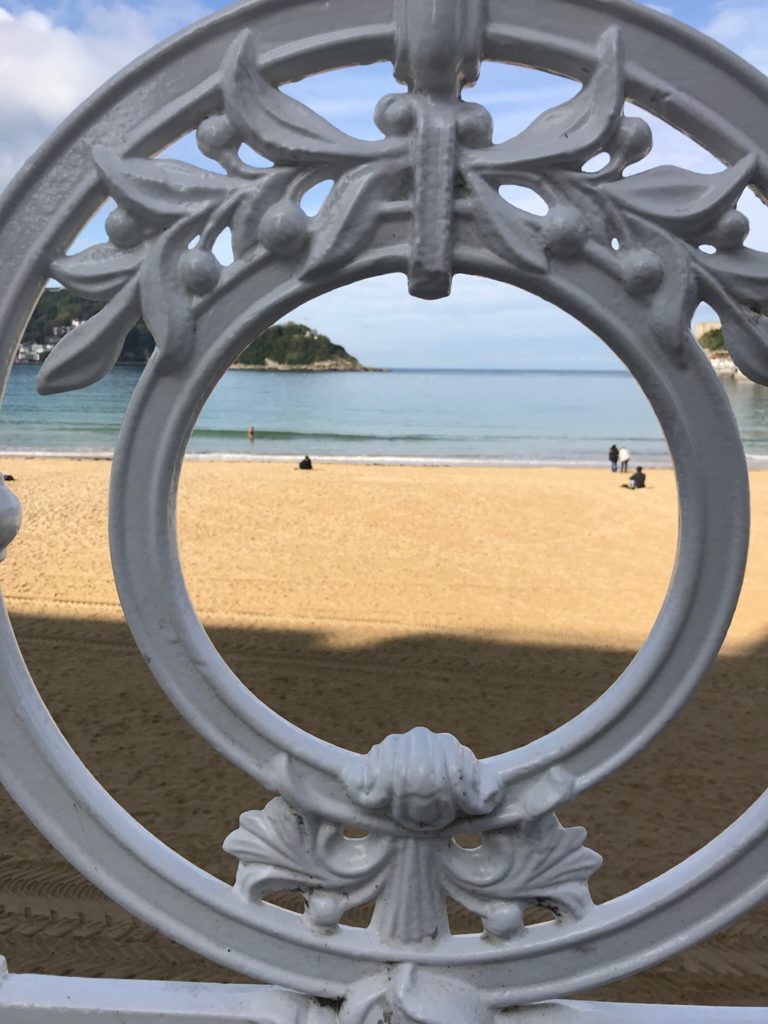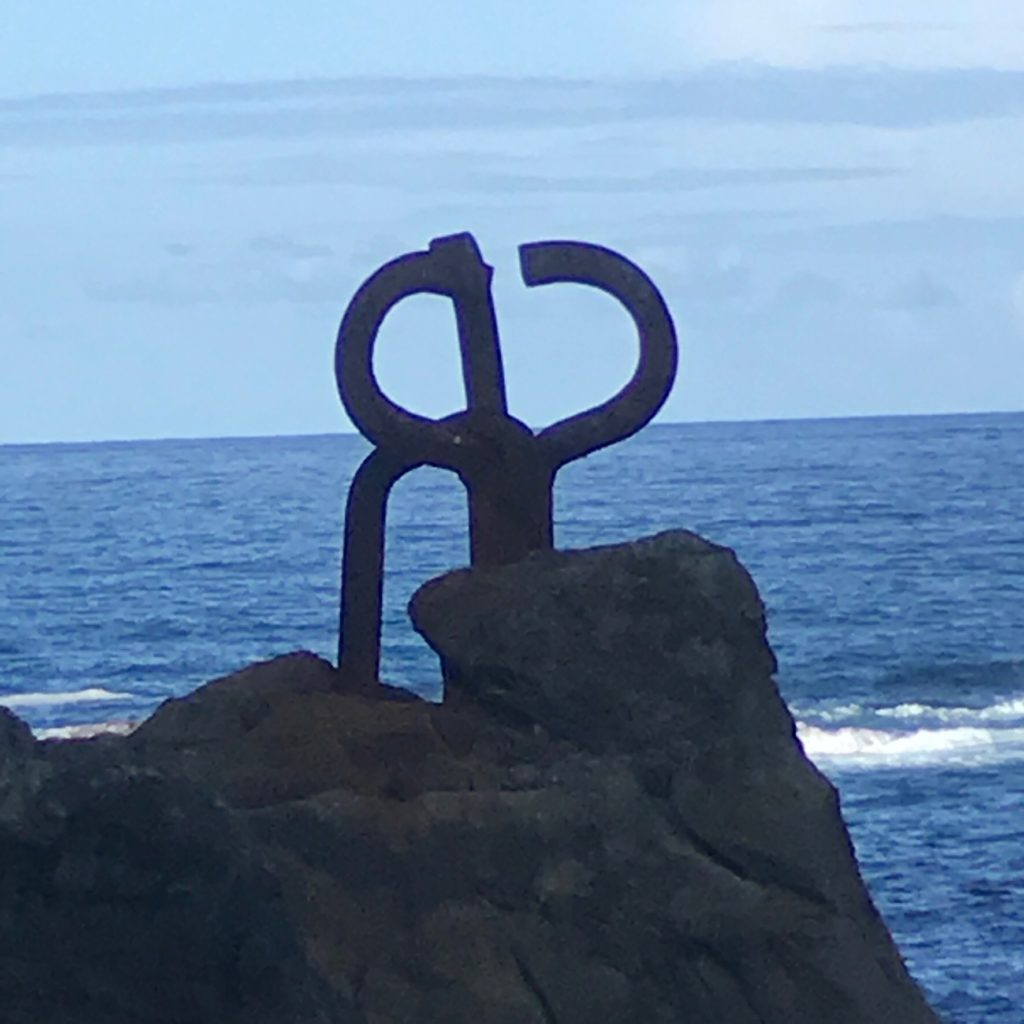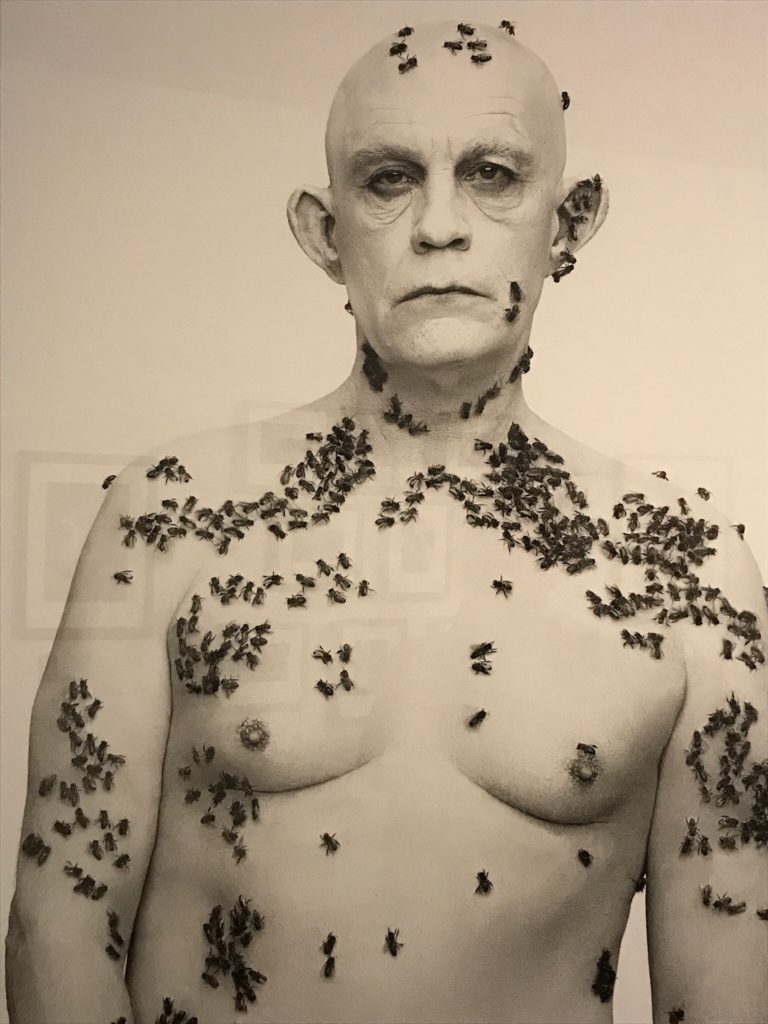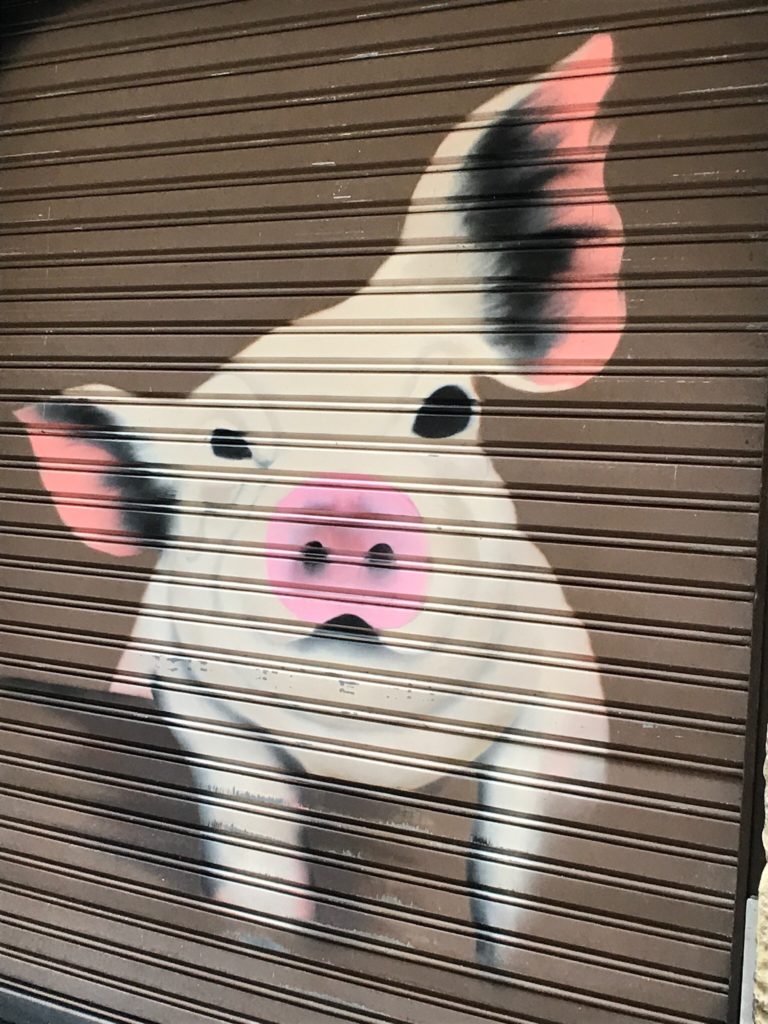21-23 October 2019
Jumping back on the Euskotren, we return to the Basque stronghold of Donostia, or San Sebastián as we call this fabulous city curling around the Bay of Biscay. With the Pyrenees Mountains to the east, tree-covered Mount Urgull and Mount Igueldo hugging either side of the bay, pristine beaches and a plethora of Pintxos, what’s not to love?
I read that some people refer to San Sebastián as a “mini Paris, Basque style.” As a city known to have the highest concentration of bars in the world, I would describe it more aptly as Las Vegas with a beach – but, with so much more history, architecture, and food!

Playa de Ondarreta and Playa de la Concha (thought to be the most beautiful beach in Europe) are gorgeous stretches of sand curving around the bay from Monte Urgull to Monte Igueldo. Its long promenade is awash with sun, frisky dogs, and a few hardy sun bathers and swimmers. The ornate white railing, occasional protruding balcony, and tunnels through the rock make for an enjoyable walk above crystal clear waters and rolling waves.
Monte Urgull has served as a defensive battery for the city and has a long military history. The fortress walls were built around 1150. In 1794, its defenses were overwhelmed by French troops who then conquered the city. 1813 saw British soldiers help the Spanish fend off Napoleon’s troops (bullet holes can still be seen). Atop Urgull is an English Cemetery honoring the soldiers who died defeating those invaders. Further up is the 12th century Mota Castle, now a history museum.
Mount Igueldo is on the western corner of the bay and can be reached by a funicular railway. The attraction at the top is an amusement park that has been operating since 1911. Hopefully, the rides are not that old. There is also a 16th century square tower which once served as the lighthouse for San Sebastián. Views over the city are outstanding.

For me, I remain along the beach promenade and busy pedestrian streets of Old Town.
Luxurious mansions and resorts line the hill directly above the bay. One especially well-appointed spa is El Perlón and the La Perla Bar. Its outdoor terrace affords a fabulous view of Old Town and bay. Over a chilled glass of La Rioja, I can contemplate which home and view best suits me.
Along the length of this 3-mile promenade are several architectural and historical sites of interest: Peine Del Viento sculptures, Plaza Cervantes with its sculpture of Don Quixote and sidekick Sancho Panza, City Hall, and Basilica de Santa María del Coro. Streets and sites not to miss are 31 de Atosto, San Telmo Museum, Constitution Plaza, Sarriegi Plaza, Mercado do la Bretxa, and Plaza Gipuzkoa. Visiting these sites will fill a day.
The San Telmo Museum does an excellent job of explaining the history and culture of the Basque and San Sebastián. Free on Tuesday. Currently, there is a special exhibition of Sandro Miller’s “Malkovich, Malkovich, Malkovich: Homage to the Masters of Photography.” Excellent!
One landmark church found outside of the Parte Vieja is the late 19th century Good Sheperd of San Sebastián. According to traditional belief, San Sebastián was slain by Roman emperor Diocletian’s troops, initially being tied to a post or tree and shot with arrows, though this did not kill him; beheading him did. With its single 246-foot spire, the church can’t be missed. The façade is neo-Gothic and undergoing extensive renovation. Its interior is rather plain but there are some nice stained-glass windows. If you only have time and stamina for one church interior though, choose the more spectacular Basilica de Santa María del Coro in Old Town.

For any remaining time, do as the locals and have a drink and pintxo. Then walk a few feet to a different bar before choosing a second drink and pintxo. Repeat until it is time to go home. The selection of pintxos is astounding! You may also order a hot pintxo.
And for one of the best traditional tortilla de patatas (a delicious potato omelette), head closer to the train station to the charming Izarraitz Taberna on Prim Kalea. Twenty-eight years ago, my friend and I hosted exchange students. My friend hosted a young Iker who, like all of us, has added a few years but his Izarraitz Taberna is a wonderful neighborhood bar with lots of local atmosphere and delicious food.
Like most important cities, there are Free Walking Tours available. Google for “free walking tours of San Sebastián” and find several suggestions from which to choose. We joined Go Local for a fun and interesting two hours about Old Town. Our guide presented information on the history of the city, particularly the fire and destruction of most of San Sebastián when the British/Spanish allies defeated Napoleon’s troops in 1813. Unfortunately, the entire city was burned to the ground with only a single street unaffected; the street is today known as Calle 31 de Agosto in remembrance. It is also one of the best streets, and most expensive, for pintxo bars.

A word about Euskara. This is the language spoken in the Basque Country. Linguistically, it is unrelated to any European languages; its dialects are not related to Spanish nor French. It is spoken by less than 30% of all Basque people, mostly on the Spanish side of the Pyrenees. Though Spanish is the official language of Spain, its Constitution allows autonomous communities, such as the Basque Community, to retain Euskara as an unofficial language. Basque has no official status in the French Basque Country and use of Euskara is restricted. The Basque language is not dying, as figures show an increase in speakers over the last decade.
Basque is a tough language but learning just a couple words will endear you to the man or woman serving you the pintxos. Think “mescarycosco” for eskerrik asko to say thank you very much. For “please” imagine a Mercedes but drop the r for mesedez and one can bumble along. Hola will work for hello but in Basque it is kaixo, kind of like “casho.”
So “Kaixo, garagardo bat, mesedez. Eskerrik asko!” will get you a smile and a beer.
Parte Vieja, Old Town, is alive with music, terrific food and a different bar no further than arms’ length. It boasts of having the highest concentration of bars in the world, with which I have no argument. Pintxos are regional specialties, or finger foods, served in bars throughout San Sebastián. These delicious treats are a mix of little delicacies on a piece of bread and usually served cold at the bar. Instead of the American “pub crawl” the locals call this a “pintxo crawl.”
Each narrow, cobblestoned street has its share of places to enjoy a glass of wine or beer paired with one of its special pintxos.

Food and a relaxed atmosphere reign supreme here. San Sebastián is gaining much recognition for its cuisine and excellent restaurants. One boast by the tourism department is the city has more Michelin 5-star restaurants 16) per capita than anywhere else in the world except Tokyo. Quite a boast! I don’t know about the Michelin restaurants, but I know participating in a pintxo crawl sure ranks up there for experiences not to be missed.
0 Comments